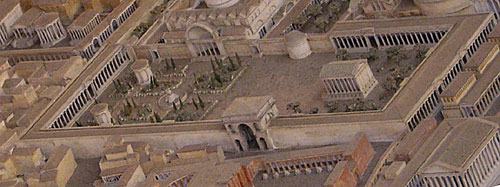
You are now at the entrance hall of the Saepta Julia, the voting place in Rome. Traditionally the Romans went to the Campus Martius to vote, where they gathered in a place known jokingly as the Ovile, i.e. the Sheepfold (ovis,-is, a sheep), because the various electoral sections of the comitia centuriata and tributa were roped off from each other and the voters were ushered in there like sheep in a sheepfold. Caesar was the first to conceive a plan for a more dignified building to house the elections, which he decided to build on the same area as the old Ovile. So, he designed (and possibly started building) the Saepta Julia in 54 BCE, planning to cover it with marble and surround it with a lofty portico a mile long. The work, however, was not completed until much later in 26 BCE by Agrippa who had the building adorned with a number of reliefs and paintings (Richardson, 340).
The area where the Saepta Julia was built was originally depressed and very swampy, so Agrippa had to construct deep sewers, the Stagnum Agrippa and the Euripus, that helped collect the excess waters and eventually direct them to the river (Boatright, 36).
In 80 CE, the Saepta was burned in the great fire of Titus, but was immediately restored. But as the political liberties and rights of the Roman people were suppressed in the later years of the empire, the building lost its significance and was turned into a big bazaar specializing in luxury goods. Sometimes it was even used for staging gladiatorial shows and gymnastic exhibitions, or for assemblies of the people or the senate.
Today, the only thing that remains from the Saepta is a stretch of wall that is visible east of the Pantheon. For more information on the building, its function, the meaning of its name or Roman elections, click on the capsa to read the scrolls that are stored in there. If you wish to see the rest of the building, proceed south to the portico.